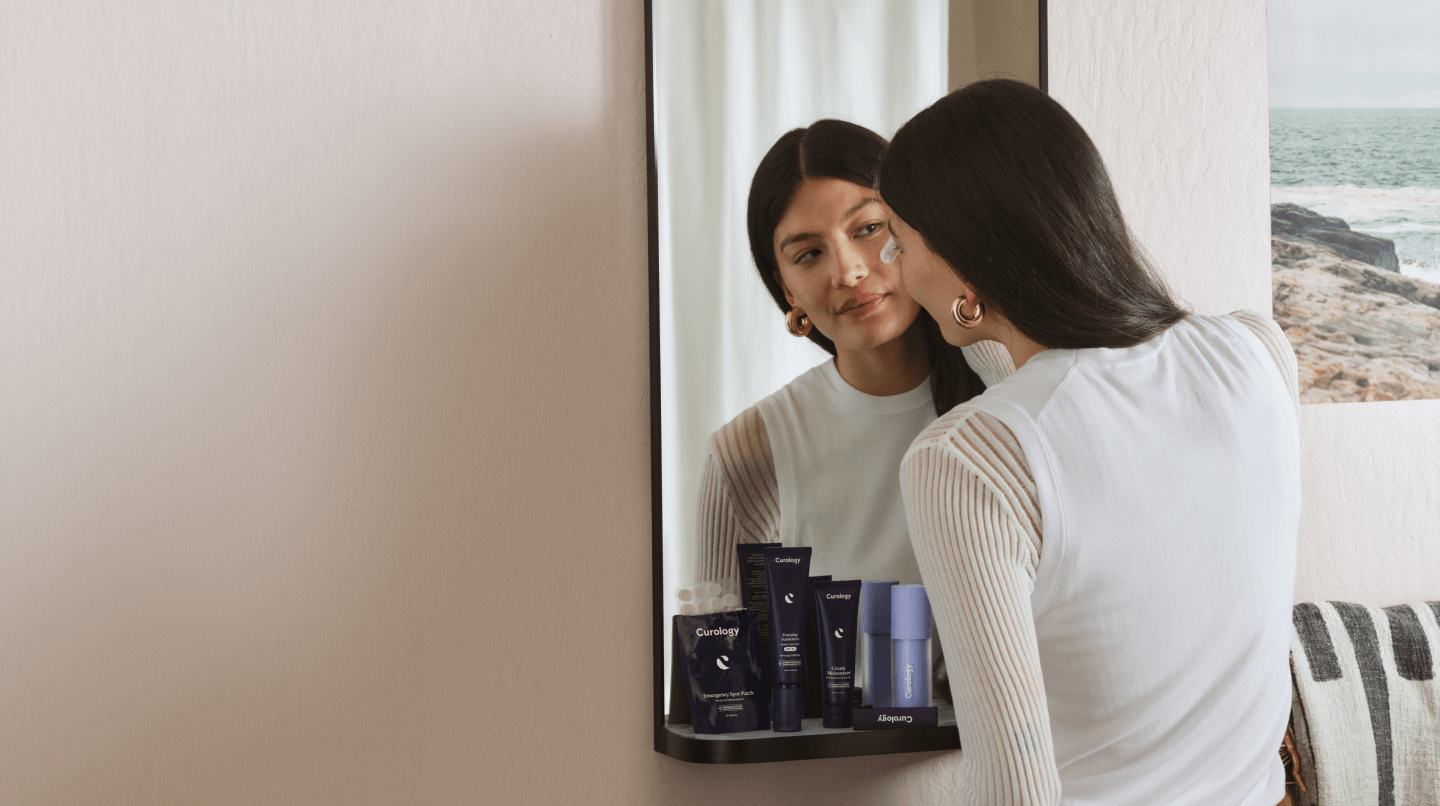How it works:
Share your skin goals and snap selfies
Your dermatology provider prescribes your formula
Apply nightly for happy, healthy skin
How it works:
How it works:
Share your skin goals and snap selfies
Your dermatology provider prescribes your formula
Apply nightly for happy, healthy skin
How it works:
Face taping for wrinkles—what is this anti-aging trend, and does it actually work?
Skincare experts explain the science behind face taping.



Summary
It seems like every couple of weeks, our social media feeds get flooded with a new skincare trend. But a lot of the time, the skincare “solutions” that people suggest may end up causing more problems.
Sure, there are plenty of social media influencers and micro-celebrities who stick to the facts and share reliable information. Some of the tips and tricks they provide can even be helpful. But other times, when it comes to viral skincare trends, it can be difficult knowing who to trust.
Enter face taping. The “new” beauty hack hit TikTok a few months back and has gained popularity since. Now, you might be wondering: what is face taping, and does it work? We did some investigating for you—here’s what we found.
What is face taping?
In the simplest terms, face taping is pretty much exactly what it sounds like—using strategically placed pieces of tape on parts of your face to reduce the appearance of wrinkles and fine lines. There are two main methods of face-taping.
The first method would be more appropriately called “facelift taping.” It mimics the effects of having a facelift without actually going through the surgical procedure (technically called a rhytidectomy). Strips of thin medical-grade tape are placed in certain spots on the face and neck and attached to pieces of string which are tied behind the head to pull and “lift” the skin. The string is usually hidden by hair, and the tape is hidden by makeup and clever camera angles. This method is often used in the entertainment industry by makeup artists before photo shoots and by Hollywood stars before red-carpet events.
The second method of face taping—the one that made TikTok go nuts—is taping the skin on your face overnight to smooth out your skin and reduce expression lines (aka the lines caused by frowning, smiling, laughing, or other facial expressions). The claim is that this restricts the movement of facial muscles and prevents expression lines from forming while you sleep. And this isn’t some amazing new “hack,” either. In fact, Frownies, one of the original wrinkle-fighting face patch developers, originated in 1889.¹
Does taping your face really work?
Temporarily, yes, face taping will “lift” your skin and smooth out wrinkles and lines. But will it remove the lines and wrinkles that already exist, or keep future lines and wrinkles from forming? No, not even a little bit. In fact, it might make your lines deeper and more pronounced.
It helps to understand where lines and wrinkles come from in the first place. Expression lines—the ones created by smiles and frowns and laughs—form naturally over time due to a variety of factors, including the decrease in collagen production as we age.² Collagen is the protein that helps keep our skin firm, tight, and wrinkle-free.³ However certain wrinkle patterns in particular, such as crow’s feet, smile lines, or frown lines, may be exaggerated due to repeated facial movements and expression.⁴ Unless you never move a single muscle on your face (which seems improbable!), expression lines are inevitable.
Our skin and muscles have a certain amount of natural elasticity, mostly due to collagen and its cousin, elastin. Because of this elasticity taping may temporarily smooth out lines and wrinkles. But those lines and wrinkles can come back as soon as the tape is removed or shortly after, even if it did stay on your face through the night.

When you put tape on your face to keep your muscles from moving, it doesn’t stop your muscles from trying to move. And when you add resistance, that might end up giving your facial muscles a little mini-workout while you sleep. Instead of keeping wrinkles from forming, you could end up deepening the lines you intended to smooth out and making them more prominent.
Face-lift tape can be effective in creating the appearance of smoother skin, but it’s just an illusion and not a permanent fix. The success of this technique depends on many factors, including the placement of the tape, how well the string is hidden, and lighting and camera angles. And as soon as you take it off, your face will go back to its natural shape.
Is face-taping safe?
Generally speaking, occasional face-taping isn’t necessarily harmful, but there are definitely things to be cautious about. Namely, the adhesive on the tape. Most tapes aren’t made for the skin, and some adhesives can be irritating. Some adhesives may also clog the pores and contribute to acne breakouts.
Even a weak adhesive can cause damage to the skin barrier and strip natural oils. That risk only increases with stronger adhesives—even medical tapes intended for skin contact carry risks.⁵ Some other possible complications of adhesives include:
Painful removal
Irritation
Allergic reaction
Bleeding
Tearing
Scarring
Unless you don’t move at all during your sleep, it’s going to take a pretty strong adhesive to stay on overnight. Then again, if you don’t move your muscles during sleep, there really isn’t any point in overnight face-taping anyway. But if you’re like most people, you do move around a fair amount throughout the night, and the normal household tape that you wrap birthday presents with probably isn’t going to cut it (no matter what they tell you on TikTok).
Anti-wrinkle prevention and treatments that work
It’s widely accepted that frequent and prolonged exposure to the sun contributes to signs of skin aging, including wrinkles and sunspots, among others. The clinical term for this process is “photoaging.” UV rays aren’t the only kind of light responsible for aging—there’s increasing evidence that visible light and infrared light play a role, too.⁶
One of the best ways to protect your skin from photo damage is to use sunscreen with SPF 30 or higher. Find one with added antioxidants to increase your protection against infrared light.⁷ Also of note: According to the Skin Cancer Foundation, regular use of sunscreen significantly reduces your risk of developing skin cancer.⁸
For treatment of fine lines and wrinkles that have already formed (or are starting to form), there’s really no way to get rid of them completely. They’re almost inevitable, but there are a few ways to reduce their appearance which don’t involve tape.
One of the easiest ways is to use a good moisturizer. Keeping the skin hydrated and trapping moisture under its surface can help reduce the appearance of some fine lines.⁹ In general, it’s helpful to use products appropriate for your skin type, or you might experience irritation.
Diet can also play a major role in slowing the signs of aging, especially foods that are high in vitamin C or linoleic acid.¹⁰ There’s also evidence linking diets high in red meat and snack foods to skin wrinkles in women.¹¹ You don’t have to completely avoid steak or potato chips, but limiting them while increasing your intake of fruits, vegetables, and legumes may help reduce wrinkles as you grow older.

There are other anti-aging treatments as well, such as topical treatments containing retinol or tretinoin that aim to boost collagen production and increase cell turnover. But everyone’s skin is unique, and what works for one person might not be as effective for the next. That’s why Curology specializes in personalized treatment solutions such as our HydroTretᴿˣ formula. A consultation with a licensed dermatology provider at Curology can help you find a solution for your skin concerns.
Finding solutions for your skin
Taping your face can have very minor and extremely temporary effectiveness in smoothing wrinkles and fine lines, and giving the face a lifted look. But there are more effective methods of prevention and treatment. Sunscreen (and other sun protection measures) is still the number one best protection against skin damage, but diet, moisturizers, and some topical treatments have been shown to be effective in reducing wrinkles and fine lines and may enable you to age gracefully on your own terms.

Get your personalized skincare routine with Curology
Get your personalized skincare routine with Curology


If you want to take the guesswork out of skincare, we’re here to help. Curology was founded by a board-certified dermatologist to help make effective skincare more accessible—our team of licensed dermatology providers is ready to work with you to find a personalized solution for your skincare needs. Sign up at Curology today for a 30-day trial* and take the first step on your skincare journey.
FAQs
Softer, looser skin is a part of aging that’ll eventually be unavoidable for most of us, but there are safe options to slow down that process and to tighten loose folds of skin around the face and neck, from products that contain retinoids to laser resurfacing and radiofrequency therapy.¹²
Occasional face taping isn’t necessarily a bad thing, although you might be disappointed in the actual results after all the hype. But when it’s done every day, you increase the risk of irritation, bruising, tearing, and otherwise damaging your skin, not to mention the potentially pore-clogging adhesives that can cause breakouts.
Not by itself. Sagging skin is a natural occurrence that results from decreased collagen and elastin production, and while some external factors can speed that process along, any stretching caused by taping would likely be too minimal and gradual to be permanent.¹³
P.S. We did the homework so you don’t have to:
Frownies–The Original Wrinkle Patch. History of Frownies. (n.d.).
De Faria, J.C., et al. Skin aging and collagen. Rev Hosp Clin Fac Med São Paulo. (1995, n.d.).
Ganceviciene, R., et al. Skin anti-aging strategies. Dermatoendocrinol. (2012, July 1).
Campiche, R., et al. Facial Expression Wrinkles and Their Relaxation by a Synthetic Peptide. International Journal of Peptide Research and Therapeutics. (2020, November 29).
Zeng, L.A., et al. Comparison of Medical Adhesive Tapes in Patients at Risk of Facial Skin Trauma under Anesthesia. Anesthesiology Research and Practice. (2016, June 12).
Kim, E.S. and Kang, C. Consider using a broad-spectrum sunscreen daily to prevent photoaging. Drugs & Therapy Perspectives. (2022, June 20).
Kim, E.S. and Kang, C. Consider using a broad-spectrum sunscreen daily to prevent photoaging. Drugs & Therapy Perspectives. Ibid.
The Skin Cancer Foundation. Sunscreen. (2023, n.d.).
American Academy of Dermatology Association. Wrinkle remedies. (n.d.).
Cosgrove, M.C., et al. Dietary nutrient intakes and skin-aging appearance among middle-aged American women. American Journal of Clinical Nutrition. (October 2007).
Mekić, S. et al. A healthy diet in women is associated with less facial wrinkles in a large Dutch population-based cohort. Journal of the American Academy of Dermatology. (2018, March 27).
American Academy of Dermatology Association. Many ways to firm sagging skin. (2023, n.d.)
Zhang, S. and Duan, E. Fighting against Skin Aging-The Way from Bench to Bedside. Cell Transplantation. (2018, April 25).
Laura Phelan is a board-certified Family Nurse Practitioner at Curology. She earned her Masters of Science in Nursing at Benedictine University and went on to get her post-master’s certificate as a Family Nurse Practitioner at the University of Cincinnati.
*Cancel anytime. Subject to consultation. Results may vary.

Curology Team

Laura Phelan, NP-C
Related Articles
Choosing the right sunscreen: Why non-comedogenic options are a game-changer for clear skinIs your makeup pilling? Here’s how to help prevent it from happeningThe ultimate guide to face exfoliators: Our 5 picks for glowing skinWhat’s the deal with Curology?5 Popular Skincare Ingredients and What They DoPopular Articles
Ask Curology: Is my cold breaking me out?Slugging: The dermatologist-approved skincare hack going viral on TikTokTretinoin vs retinol: What’s the difference?How to create a self-care routine that actually sticksYour 2023 skincare horoscopeTry prescription skincare
Get routine essentials


Face what’s next with Future-ProofRx
Face what’s next with Future-ProofRx
- Skin texture
- Fine lines
- Wrinkles
- Dark spots
- Dullness
$29.95/month